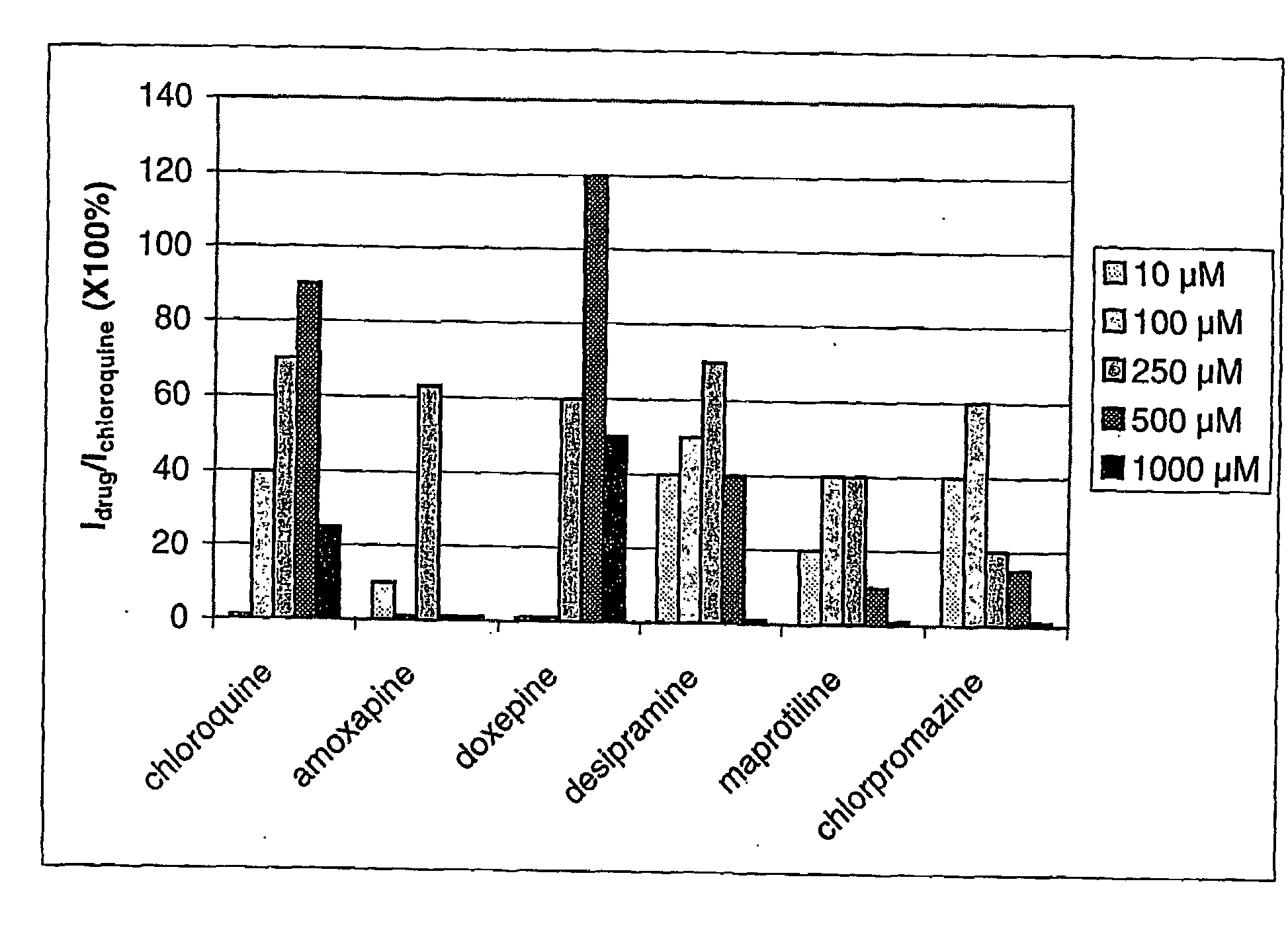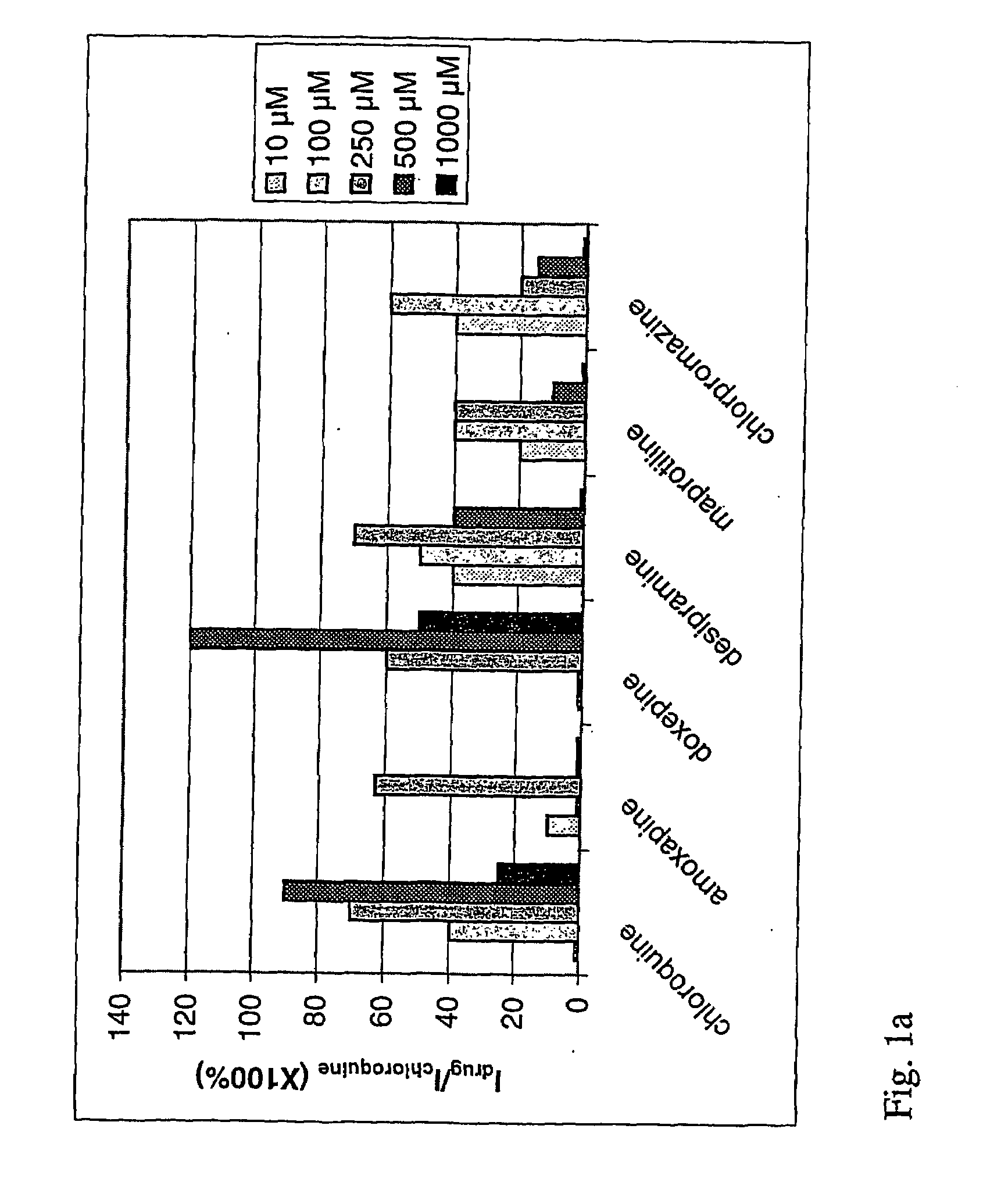Use of a Tricyclic Antidepressant Drug For Promoting Endocytosis
a tricyclic antidepressant and endocytosis technology, applied in the direction of biocide, plant growth regulators, pharmaceutical non-active ingredients, etc., can solve the problems of inconvenient auxiliary agents such as low-molecular active ingredients favored up to now in the pharmaceutical industry, degradation of dna-induced cell degradation, and inability to transfer to the active position,
- Summary
- Abstract
- Description
- Claims
- Application Information
AI Technical Summary
Benefits of technology
Problems solved by technology
Method used
Image
Examples
example 1
Active Ingredient Comprising a Nucleic Acid (Test Form)
[0031]For the purpose of measuring the substances according to the invention promoting the endocytosis, the plasmid described in the following was used as a model active ingredient. The plasmid pFL1 was used, as described in the document D. Botstein et al., Gene 8:17-24 (1979). pFL1 is a 2 μm circular plasmid for Saccharomyces cerevisiae (Sa) with a high copy number. It contains the Sa gene URA3 as a selective marker for ura3auxotrophic yeast strains and parts of the pBR322 E. coli plasmid for the replication and selection in E. coli. The plasmid was held in E. coli SF8 and purified with the Qiagen Plasmid Mega Kit (Qiagen, Hilden, Germany).
[0032]For luciferase cell culture assays, the luciferase gene was cloned with NotI (NEB) in pBlueskript SK (+) (Stratagene, Heidelberg, Germany), and that under the control of a CMV promoter and a SV40 poly-A signal. This plasmid was amplified in E. coli DH5α. The DNA was purified with the Q...
example 2
Model Target Systems
[0033]A first cell system is a yeast system. The transfection protocol corresponded to that of the document B. Neukamm et al., Biochimica et Biophysica Acta 1572:67-76 (2002). For the measurements, a lab robot (Zinsser, Frankfurt, Germany) was used, and a pipetting protocol was prepared.
[0034]Yeast precultures were drawn from cultures of a −70° C. glycerol stock of the strain RPY10 (R. C. Piper et al., Eur J Cell Biol 65:305-318 (1995)) for 72 hours. In the main culture, the cells were drawn over night in YPD medium up to a cell density of 5 to 8·107 cells / ml. 12·109 cells were harvested and washed twice with the same volume of distilled water. The cells were made competent for the transfection by soaking in distilled water for 30 minutes at 4° C. The competent cells were harvested and resuspended in 10 ml 34% sucrose, adjusted with HCl to pH 4. The suspension was immediately transferred into a sterilized 40 ml glass tube (Zinsser Analytik, Frank...
example 3
Determination of the Optimum Concentrations
[0039]For each used substance, the optimum concentration was determined by means of concentration series. For this purpose, concentration series of the respective substances were used. For comparing, corresponding measurements were performed with chloroquine. The results are shown in FIGS. 1a (yeast cells) and 1b (mammal cells system). The ordinate values are standardized to chloroquine. It can be seen that in the case of the substances amoxapine, maprotyline and chlorpromazine, the optimum concentrations are smaller than in the case of chloroquine. In principle, with regard to side effects, as low concentrations as possible are desirable and advantageous. Only in the case of doxepine, the optimum concentration is similarly high as for chloroquine.
PUM
| Property | Measurement | Unit |
|---|---|---|
| Molecular weight | aaaaa | aaaaa |
Abstract
Description
Claims
Application Information
 Login to View More
Login to View More - R&D
- Intellectual Property
- Life Sciences
- Materials
- Tech Scout
- Unparalleled Data Quality
- Higher Quality Content
- 60% Fewer Hallucinations
Browse by: Latest US Patents, China's latest patents, Technical Efficacy Thesaurus, Application Domain, Technology Topic, Popular Technical Reports.
© 2025 PatSnap. All rights reserved.Legal|Privacy policy|Modern Slavery Act Transparency Statement|Sitemap|About US| Contact US: help@patsnap.com



